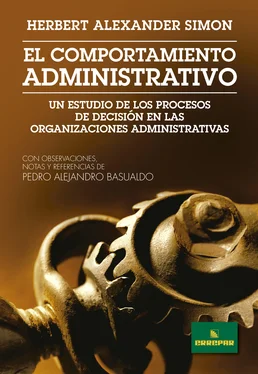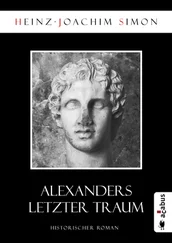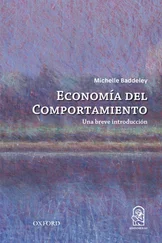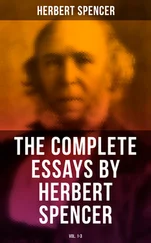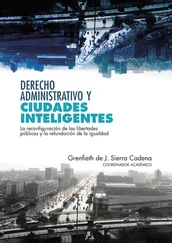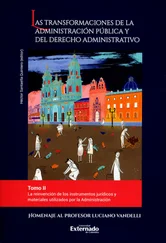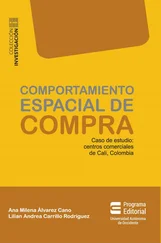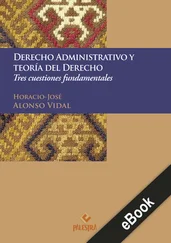(1941).Measurement techniques in administrative research. Civic Affairs , 8 (9); 1-2; 5-8.
SIMON, H.A. & BARENFELD, M. (1969).Information-processing analysis of perceptual processes in problem solving . Psychological Review , 76: 473-483.
SIMON, H.A., & DIVINE, W.R. (1941).Controlling human factors in an administrative experiment. Public Administration Review , nº 1: 485-492.
SIMON, H.A., DIVINE, W., COOPER, E. & CHERNIN, M. (1941.b).Determining work loads for professional staff in a public welfare agency. Bureau of Public Administration, University of California, Berkeley.
SIMON, H.A. & HAYES, J.R. (1976.b).The understanding process: Problem isomorphs. Cognitive Psychology , 8, 165-190.
SIMON, H.A., KOZMETSKY, G., GUETZKOW, H. & TYNDALL, G .
(1955).Organizing for controllership: Centralization and decentralization. The Controller , 33, 11-13.
(1954).Centralization vs. decentralization in organizing the controller’s department. New York, NY: The Controllership Foundation.
SIMON, H.A. & LEA, G. (1974).Problem solving and rule induction: A unified view .En L.W. Gregg (Ed.), Knowledge and cognition: Capítulo 5. Potomac, MD: Erlbaum.
SIMON, H.A. & NEWELL, A.
(1971).Human problem solving: The state of the theory in 1970. American Psychologist , 26: 145-159.
(1965).Heuristic problem solving by computer. In M.A. Sass & W.D. Wilkinson (Eds.), Computer argumentation of human reasoning (pp. 25-35). Washington, DC: Spartan Books.
(1962).Computer simulation of human thinking and problem solving .En M. Greenberger (Ed.) Management and the computer of the future : 94-133. New York, NY: John Wiley & Sons.
(1958).Heuristic problem solving: The next advance in operations research. Operations Research, 6: 1-10.
SIMON, H. & WALLACH, D. (1999). Cognitive Modeling in Perspective. Springer Verlag, K.W., 8 (1): 1-4.
STAMAN, R. (1938).What is the Most Economical Case Load in Public Relief Administration . Social Work Technique , Vol. 4: 117-121.
STARBUCK, W. (ed.) (1971).Organizational Growth and Development. Penguin Books, Middlesex, Harmondsworth, UK.
STARBUCK, W. (1971).Introductory Essay. En Organizational Growth and Development , Starbuck (ed.). Penguin Books, Middlesex, Harmondworth, UK.
TABACHNECK – SCHIJF, H.J.M., LEONARDO, A.M. & SIMON, H.A. (1997).CaMeRa: A computational Model of Multiple Representations . Cognitive Science , Vol 21 (3): 305-350.
TABACHNECK – SCHIJF, H.J.M. & SIMON, H.A. (1994).What you see is what you get – but do you get what you see ?Conference on Human Factors in Computing Systems, pp. 293-294. Boston, MA.
TAYLOR, F.W.
(1911).Shop Management. Harper & Brothers, New York.
(1907).On the Art of Cutting Metals. American Society of Mechanical Engineers, New York.
THEOBALD, A. & NICHOLSON CROTTY, S. (2005).The Many Faces of Spam of Control: Organizational Structure across Multiple Goals . Administration Society , January 1, 36 (6): 648 – 660.
URWICK, L.F.
(1956).The Manager’s Span of Control . Harvard Business Review 55 (3): 39-47.
(1945).The Elements of Administration. Harper & Brothers, New York.
(1937.c).Science, Values, and Public Administration. En Papers on the Science of Administration (Capítulo XI) , editado por Luther Gulick and Lyndall Urwick, New York Institute of Public Administration, Columbia University.
(1937.b).The Function of Administration (with Special reference to the work of Henri Fayol). En Papers on the Science of Administration (Capítulo IV) , editado por Luther Gulick and Lyndall Urwick, New York Institute of Public Administration, Columbia University.
(1937.a).Organization as a technical Problem. En Papers on the Science of Administration (Capítulo II) , editado por Luther Gulick and Lyndall Urwick, New York Institute of Public Administration, Columbia University.
WALLACE, D. (1941).Federal Departmentalization: A Critique of Theories of Organization .Columbia University Press, New York.
WHITE, L. (1939).Introduction to the Study of Public Administration. Macmillan, New York.
WILLIAMSON, O. (1990).Organization Theory: From Chester Barnard to the Present and Beyond. New York: Cambridge University Press.
WOODWARD, J. (1965).Industrial Organization: Theory and Practice .Oxford University Press, London.
29. De los mismos autores, con idéntico título (Pugh, et al., 1969).
CAPÍTULO III
TEXTO ORIGINAL
CAPÍTULO III
HECHO Y VALOR EN LA TOMA DE DECISIONES
En el Capítulo I se señaló que toda decisión implica dos tipos de elementos, y se los llamó “fácticos” y “de valor”, respectivamente. Esta es una distinción que resulta esencial para la administración. Primero que nada, nos lleva a entender qué se quiere decir con una decisión administrativa “correcta”. En segundo lugar, aclara la diferenciación, que a menudo se realiza en la literatura, entre cuestiones de política y de administración. Estos importantes problemas serán tema del presente capítulo.
Para fundamentar la respuesta a estas cuestiones sobre primeros principios, sería necesario que este volumen sobre administración estuviera precedido por un tratado filosófico todavía más extenso. Las ideas necesarias ya están disponibles en la bibliografía sobre filosofía. Por ello, se admitirán como punto de partida las conclusiones a las que llega una escuela determinada de la filosofía moderna –el positivismo lógico– y se analizarán sus implicancias para la teoría de las decisiones. El lector que tenga interés en examinar el razonamiento sobre el cual se basan estas doctrinas podrá recurrir a las referencias bibliográficas indicadas en las notas al pie de este capítulo.
DISTINCIÓN ENTRE SIGNIFICADO FÁCTICO Y ÉTICO
Las proposiciones fácticas son afirmaciones sobre el mundo observable y la forma en que este opera. (1) En principio, es posible poner a prueba las proposiciones fácticas para determinar si son “verdaderas” o “falsas” –si lo que dicen acerca del mundo sucede realmente o no.
Las decisiones son algo más que proposiciones fácticas. Sin lugar a dudas, describen un estado de cosas a futuro, y esta descripción puede ser verdadera o falsa en un sentido estrictamente empírico; pero poseen, además, una calidad imperativa: seleccionan un estado de cosas a futuro con preferencia a otro y dirigen los comportamientos hacia la alternativa elegida. En suma, tienen un contenido “ético” además de fáctico.
La cuestión de si las decisiones pueden ser correctas o incorrectas se convierte, entonces, en la cuestión de si los términos éticos, como, por ejemplo, “deber ser”, “bueno” y “preferible”, tienen un significado puramente empírico. Una premisa fundamental de este estudio es que los términos éticos no se pueden transformar por completo en términos fácticos. De ninguna manera se intentará aquí demostrar en forma concluyente que esta opinión acerca de las proposiciones éticas es correcta; los positivistas lógicos y otras escuelas han justificado extensamente este punto. (2)
Читать дальше
